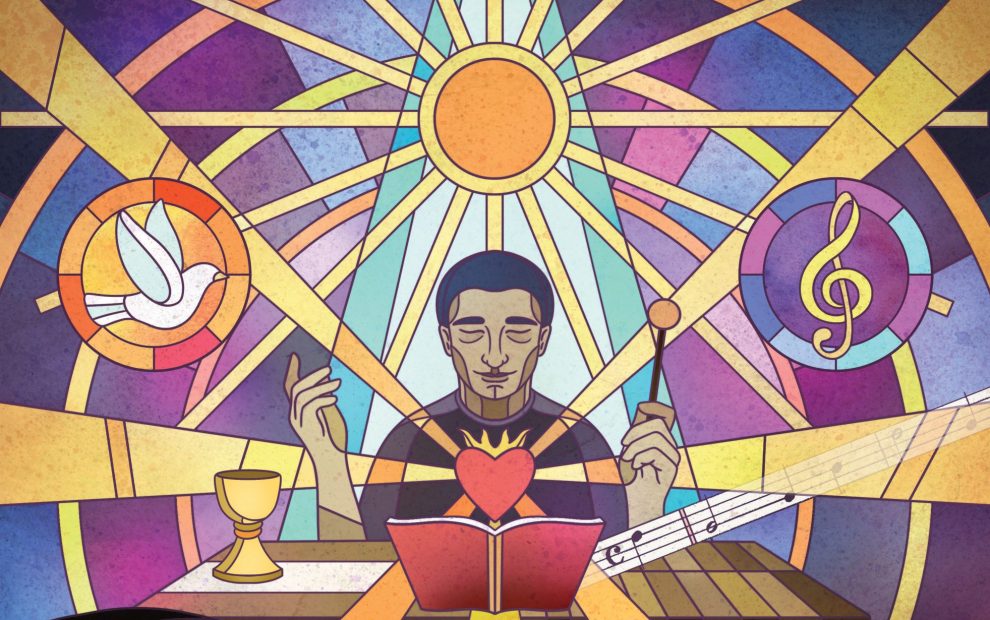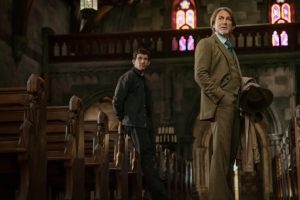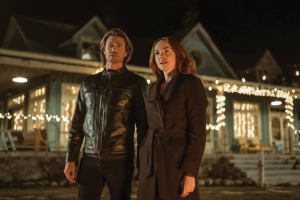Talking about his late friend Thomas Merton, acclaimed jazz vibraphonist Dick Sisto says jazz resembles Merton’s own approach to writing. Sisto, a former seminarian and lifelong Catholic, says Merton was kind of a “jazz writer,” which might partially explain the monk’s well-documented affinity for jazz.
According to Sisto, jazz is “all about taking the elements and reinventing” them in the moment. The soloist’s job is not to stand apart but to make a “statement” on the song before handing it back. The image of passing elements back and forth reminds me of the Last Supper, when, after blessing and breaking the bread, Jesus gave it to his disciples, saying, “Take, eat; this is my body.” That’s just the way jazz works, Sisto says, and if not, then it “doesn’t sound right.”
I spoke with Sisto because I was curious about several famous 20th-century Catholics who were either jazz fans or jazz musicians, and Sisto not only knew Merton well, but he also had an illustrious music career. But that wasn’t all—Sisto’s comment that jazz without improvisation “doesn’t sound right” revealed to me my own deeper motivation for this interview: Something about Catholicism didn’t sound right.
A faith like jazz
What bothered me, what was off about the key, was the church’s claim to be a case-closer, the custodian of the law-set-in-stone rather than the mystical body of the living Word. The faith entailed in jazz, the risky trust required to improvise on a theme, is not reminiscent of today’s church, where there seems to be a deep desire for certainty, a score to perform, and a value system of virtuosity rather than ingenuity: Whoever renders the score closest to “perfect” is the best. “The score has been written—now play it exactly as it was written,” the traditionalists seem to say.
Sisto helped me realize that what I was really looking for was a paradigm analogous to sacred tradition itself and a praxis for synodality. I found both in jazz.
The spirit and method of jazz offer a spiritual model to Catholics who deeply desire to participate in a vibrant tradition. Jazz is an idiom of resilience, crafted and refined in response to powerful forces of racism and disenfranchisement. Catholicism, likewise, is an idiom of resurrection, incarnated in response to powerful forces of sin and death. Just as the jazz ensemble is a community of persons irreducible to its parts, so too is the Trinity, as well as the church and tradition; tradition has essential elements, upon which different voices through the ages have offered statements. For a time, akin to the jazz soloist, one voice or another may take the lead, but none can live outside the whole.
The church’s communion relies on a listening charism, characterized by a precarious balance. In The Meaning of the Church (Cluny Media), Romano Guardini describes it as an “evident unity replete with an inner tension”—something a musician might call harmony, born just as much from the receptive ear of the player as from the musician’s sound. In fact, similar to the early church, the first jazz musicians played not by reading notes but by hearing them. Furthermore, the church’s unity cannot be maintained by merely imposing a common structure but rather by finding a shared orientation. Pope Benedict XVI superbly expressed that orientation in Caritas in Veritate (On Integral Human Development), writing that “Truth, in fact, is lógos which creates diá-logos, and hence communication and communion.”
Sisto tells me that truth is not static but “dynamic, like jazz”—and that’s why he’s proud to be a Catholic. His faith, like his music, has to be “accurate, expressive, and embraced,” and he has to “actually live it.”
Living faith
In a National Catholic Register article, Msgr. Charles Pope writes that the church and its
teachings are Jesus’ “living and active presence” in the world. Though perhaps unlikely bedfellows, Pope’s phrase reminds me of bebop saxophone legend Dexter Gordon’s assertion that “jazz is living music.”
Each of these symmetrical ideas finds support in their respective canons. As Albert Murray wrote in his seminal 1970 essay, “The Blues Idiom and the Mainstream,” the jazz musician is “extemporizing in response to the exigencies of the situation,” transcending great evils by “playing to the possibilities that are also there.” In a similar way, Pope Francis describes the church as a perennial pilgrim, moving and breathing with the Holy Spirit, who, according to the Apostolic Constitution Dei Verbum (On Divine Revelation), nudges the church “toward the fullness of divine truth until the words of God reach their complete fulfillment in her.”
This is a profound idea that implicitly admits that the church’s present expression of the divine lógos is incomplete and in need of more diá-logos. Far from being a cause for panic, this is good news. In fact, this very lack of fulfillment characterizes the church’s life.
Jazz and religion, faith and mystery
Living traditions—such as jazz and the church—contain an inexhaustible element of surprise. The gestation and birth of this surprise require, in the words of Pulitzer-winning jazz trumpeter Wynton Marsalis, “creativity, communication and community.” As in the jazz method described by Sisto, as well as in Pope Francis’ articulation of synodality, the surprise is “in the moment”; we see it in the now, rather than the past or future.
The church calls this kairos—God’s opportune time. This means the church’s progressive fulfillment is more than a matter of outcome; it is a matter of process. This is why Pope Francis has referred to the spiritual life as a “path of growth” that requires us to be part of a “journeying community.”
Kirk Whalum, the Grammy-winning Catholic saxophonist of “I Will Always Love You” fame, tells me that while onstage, the willingness to be surprised is prayerful, even mystical. “I take a deep breath, and I don’t know at all—except given a framework—what I’m going to play,” Whalum says. “That is improvisation. That reeks of the divine, that reeks of God.”
When we take deep breaths and act without knowing the outcome, we need something far greater than courage; we need faith. Faith begins in the space beyond certainty. The Catholic word for this space—where faith becomes necessary—is mystery.
“When we talk about the Eucharist, we talk about mystery,” Whalum says. “It makes sense to me that it would be communicated in ways that are mysterious. Jazz is that—it opens us up to the fact that this is a mystery.”
Mystery and faith, with their requisite freedom and responsibility, can be frightening. (What if I believe the wrong thing?) The very first words of the Mass acknowledge the gravity of our situation: Let us prepare our hearts and minds to celebrate these sacred mysteries. Faith is the answer to our fear. As Whalum tells me, God already knows what will happen. “You and I are just seeing how it plays out,” he says.
Ultimately, a living truth must be lived. We can do this only together, with the grace of God. In doing so, we can learn from jazz musicians to be open to the possibilities, to take a deep breath and let God work. Rather than viewing ambiguity or uncertainty as threats to be contained, we reenvision them as opportunities for grace, for holy surprise.
This attitude of openness leads to a spiritual life that’s filled with excitement. Instead of allowing the unknown to fill us with fear and anxiety, we can face it with thrilled delight. The jazz ensemble trusts each other to play not the single “right” note but simply the next one, the one that in the fullness of time will be made right; if the church can do the same, God will have room to sing through us in that eternal voice that confounds human sense and liberates humanity.
A dynamic church
A Vatican statement released September 16, 2024 in the lead-up to the second session of the Synod on Synodality indicated the assembly would close their pre-session retreat with a penitential liturgy presided over by Pope Francis. One of the sins to be confessed was “using doctrine as stones to be hurled”; the liturgy aimed to convey to young Catholics that the “future of the Church is theirs” and that the church is committed to a “dynamic of conversion.” More than any other piece of language to come out of the synod, that statement gives me hope.
The word dynamic comes from the Greek dunamis, used 117 times in the Christian scriptures to connote the power flowing from the Godhead through Christ, enabling believers to do what they otherwise could not. This economy of grace and faith is analogous to Whalum’s description of jazz as opening “us up to the fact that is a mystery.” A “dynamic of conversion” is essential for all Christians.
Ella Fitzgerald’s 1974 live recording of “It Don’t Mean a Thing,” performed at the legendary London club Ronnie Scott’s, demonstrates this dynamic. Dominated by stage banter and improvised scatting, the record contains a survey of genres, ranging from songbook, country western, Dixie, and big band to what Fitzgerald calls “Soul Train music.” After five minutes of sheer musical brilliance, she states her point: “No matter what kind of music . . . it don’t mean a thing if it ain’t got that swing.” She drives home her message with another two minutes of “doo-wop, doo-wop, doo-wop.” Fitzgerald, a revered and aging artist, playfully acknowledges the innovations of younger generations while masterfully reminding her audience that what matters is not the technique but the ingredients.
Every member of a jazz ensemble liberates their own dynamic power to play its role in a suprapersonal whole. Together, they create an entirety dedicated to the praxis of an idea: that the essential elements can imbue all manner of expression.
Jazz and religion: conduits to divine power
Raised by a Baptist preacher, a younger Whalum used to preach at his shows before his father reminded him that people had “come for the music.” Eventually, Whalum realized that playing the sax was his ministry; his music was the dunamis—the dynamic power—entrusted to him.
Merton said something similar. As conduits for divine power, we don’t need “so much to talk about God but to allow people to feel how God lives within us.” That, Merton said, “is our work.”
But to do this, God must first live within us—and we must then let divinity work through us. This process cannot be automated with standardized rubrics, but instead, it requires constant in-the-moment cooperation. Indeed, the entire Catholic Church, all 1.4 billion of us, must be playing the essential elements of the gospel, extemporizing in response to the exigencies of the situation in which we find ourselves. Only when this great big band is in motion, when it swings, when God speaks to us and through us and between us, can the living Word find complete fulfillment in the pilgrim church on Earth.
A liberated faith
For too long we have sought to imprison that Word. The Vatican itself admits our monumental failure to embody the lógos: In its September 2024 statement, Rome confessed the church has lost a “faith-filled and missionary credibility that must be reestablished.”
On the final track of Moor Mother’s 2021 masterpiece Jazz Codes, audio scholar and artist Thomas Stanley preaches on jazz’s own lost “faith-filled and missionary credibility” and then offers this prayer and prophecy:
Now jazz jumps up like Lazarus if we allow it
To re-discover itself as a living music
. . . Released now from the prison bars of metrical stability
And the black and white keys of chromatic incarceration.
As Catholics, we face an enormous opportunity to also liberate our tradition from the prison bars of metrical stability. This invitation has always been there, from the very moment Jesus told our first pope, “Get behind me, Satan.”
But what does a liberated tradition look like? What is its calling card? I suggest that a liberated faith is unafraid to lose itself. Living things, including jazz and religion, are always losing what they once were to become more and more what they are. A living Catholic tradition would be so rooted in faith’s original and ever-new source that it would flow like water, like music, not worrying that it might run out of itself or be stretched to breaking.
Take as an example Mary Lou Williams’ solo recital at the 1978 Montreux Jazz Festival. Williams, a devout Catholic convert who composed numerous jazz Masses after having pioneered Kansas City Swing, opened her late-career recital with a medley (an 11-minute-and-26-second medley, to be precise), fusing Black spirituals with ragtime, old-school blues with Kansas City swing. Virtuosity was certainly in play, but the genius was in the ear, not the hand. Williams’ inclination to blend her disparate influences—influences incarnated in her as a 20th-century Black woman and jazz progenitor—into a cohesive credo was realized only at the moment of its sounding: That is living tradition, a tradition alive in Williams. Listening, I don’t get the impression that Williams was preoccupied with what she might play next; she simply continued playing because some things remain unplayed.
A Lazarus church
A Lazarus church is one that jumps up from the dead, imbued with Christ’s dynamic power. It is a church that’s unafraid, a church hungry for new nourishment, ready to breathe new winds from the Spirit, wondering with anticipation, “What’s next?” It lives in the sure knowledge that all unforeseen wonders will only enrich its lifeblood. The church’s life is self-perpetuating; by expending itself, it renews itself.
Michelina Tenace, a consultor to the Dicastery for the Doctrine of the Faith, writes in the Vatican’s newspaper, L’Osservatore Romano, that when the church engages with the world for which Christ “suffered, died, and was raised again,” it receives an “occasion to deepen her understanding of the Lord himself and of his love, and indeed of herself, an occasion to penetrate more deeply the message of salvation entrusted to her.”
This is our eternal call: To penetrate more deeply the message of salvation entrusted to us. To peer beneath its surface, below the notes on the sheet, and with the joyful awe of small children, ponder what else is living there. This is how we renew the life of our church. For people who are habitually open to possibilities, Jesus renews his invitation to conversion and replenishes his gift of dynamism.
Every step of the way
To use Whalum’s words, my conversation with him “reeked of the divine.” Afterward, I felt as though my face was shining, like I’d been flung into some strange light that changed me. I’d been dynamically converted, graced with Whalum’s insights and stories. Now I want to pass on one of the stories that spoke to me most.
On February 18, 2012, Whalum told me, he attended Whitney Houston’s funeral at New Hope Baptist Church in Newark, New Jersey. It was a long service, and everyone there was “out of their mind,” according to Whalum. “We couldn’t believe she was dead,” he says.
Houston and Whalum’s iconic collaboration, “I Will Always Love You,” played at the funeral. Though he had participated in the song’s creation and performed it live dozens of times, now, in his grief, Whalum received a new possibility for the song: He saw Jesus singing that same song to his disciples at the Last Supper.
“He had tried his best to explain to them what had to happen, and it just didn’t compute,” Whalum says. “And finally he sings, ‘If I should stay / I would only be in your way / So I’ll go, but I know / I’ll think of you every step of the way / And I will always love you.’ ”
As I listened to Whalum tell this story, I was taken totally by surprise. “I Will Always Love You” is ubiquitous, the sort of song you think you know backward and forward. Never had I expected to listen to it and hear a balladized John 14. But that’s the thing about Jesus and his body—they always do unexpected things, things that no one but Jesus sees coming.
Jesus is still walking with us, still extending the invitation to trust his plan, to not be afraid. He dreams and wills and agonizes over our every step; he wants us to get out of our own way—and his—so we can accept ourselves as his hands and feet, dancing together in a spontaneous, endless dynamic of creativity.
Who but God can tell where the music will lead us?
This article also appears in the January 2025 issue of U.S. Catholic (Vol. 90, No. 1, pages 10-14). Click here to subscribe to the magazine.
Image: Ale De la Torre













Add comment